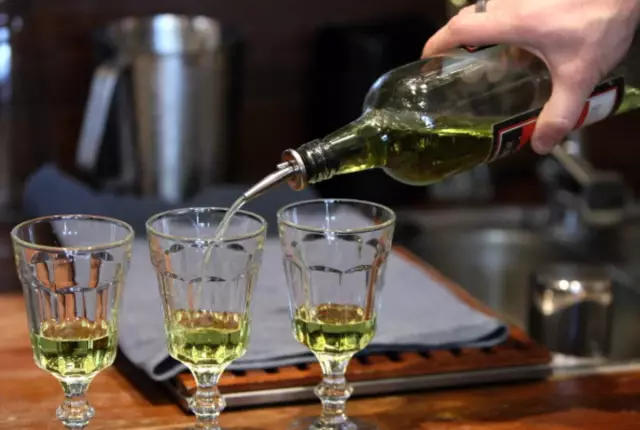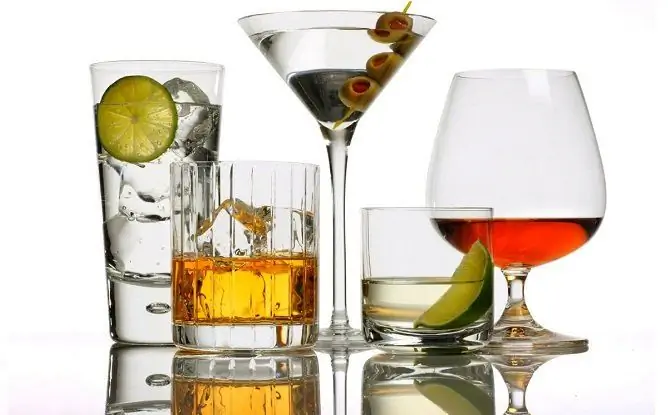- Author Rachel Wainwright [email protected].
- Public 2023-12-15 07:39.
- Last modified 2025-11-02 20:14.
Diet and alcohol

Whether it is possible to follow a diet and drink alcohol is a controversial issue. Given the variety of diets and the range of alcoholic beverages, in each case, the compatibility of diet and alcohol must be considered individually, preferably with the help of a dietitian consultation. In the recommendations of most strict diets, alcohol is categorically excluded. At the same time, if weight loss occurs due to limited calorie intake, such a diet and alcohol are quite compatible. When calculating the daily calorie intake, you should only take into account the calorie content of alcoholic beverages that you consume.
Calorie content of alcohol
The calorie content of alcohol is an indisputable fact: all substances, except for pure drinking water, which a person uses, contain calories. Moreover, the assimilation of alcohol by the body occurs without digestion: the absorption of alcohol molecules into the blood begins in the oral cavity, then it is instantly absorbed by the gastrointestinal tract and enters the circulatory system, brain, liver, supplying them with pure energy of "empty calories". The nutrients found in fats and carbohydrates are stored in reserve, increasing weight. Complicating the compatibility of diet and alcohol is the fact that drinking it increases appetite.
There are situations where alcoholic beverages can help you relax and relieve stress, have a good time in pleasant company, or improve relationships by relieving tension in a situation. If at the same time you are on a diet, alcohol should be consumed taking into account the following facts:
- The number of calories depends on the strength of alcohol: the higher the strength, the more calories and vice versa;
- The sugar and yeast content in alcoholic beverages increases their calorie content;
- Alcohol slows down the rate of fat burning, contributing to their accumulation;
- Increased appetite from alcoholic beverages can cause overeating.
The effect of negative factors is aggravated, most often not by the calories in alcohol, but by the speed and level of its concentration in the blood. The slow flow of alcohol into the blood and a low peak concentration make it possible for the body to simultaneously assimilate incoming fats, proteins and carbohydrates without putting them away in the form of extra pounds. In addition, alcohol helps relieve stress and relieves the need to “seize the problem”, which leads to weight loss.
Diet and alcohol: wine in diets
Many ballerinas prefer to lose weight by drinking red wine with predominantly red fruits or white wine with a little hard cheese. In most developed countries, it is customary to end lunch and dinner with a glass of good wine, which practically does not affect the complexion.
The properties of natural wines have been scientifically proven, useful for the functioning of the body and maintaining a figure:
- The presence of choleretic substances that enhance the secretory function of the liver, accelerates the process of digestion and excretion of food products, reduces the processes of fermentation and putrefaction in the intestine;
- Resveratrol, found in red wine, is able to normalize the level of insulin in the blood, the excess of which is often the cause of excess weight;
- The presence of a large amount of useful trace elements and salts, especially in white wine, contributes to the improved absorption of iron from food. This improves blood composition, which speeds up metabolic processes and increases energy consumption;
- The acidity of natural wine is similar to the acidity of a healthy stomach, which enhances digestion. With age, the acid content in gastric juice decreases, the use of moderate doses of wine helps to normalize acidity, improving the digestion of food and reducing its accumulation in the form of extra pounds.
An experiment on the feasibility of combining diet and alcohol, carried out by the German Wine Academy, showed that a group consuming 200 ml of dry white wine per day per day lost 20% more excess weight than a group in which wine was replaced with natural juice.
Calorie content of alcoholic beverages

It is especially important to know the calorie content of alcoholic beverages when the method of weight loss is to calculate the daily calorie intake, and is not limited to a certain set of foods.
Calories in alcohol and the amount of carbohydrates per 100 g of finished drink:
- Vodka 40% - carbohydrates 0.0, 235 kcal;
- Brandy 40% - carbohydrates 0.5, 225 kcal;
- Whiskey 40% - carbohydrates 0.0, 220 kcal;
- Gin 40% - carbohydrates 0.0, 220 kcal;
- Cognac 40% - carbohydrates 0.1, 239 kcal;
- Rum 40% - carbohydrates 0.0, 220 kcal;
- Punch 26% - carbohydrates 30.0, 260 kcal;
- Liqueur 24% - carbohydrates 53.0, 345 kcal;
- Port wine 20% - carbohydrates 13.7, 167 kcal;
- Sherry 20% - carbohydrates 10.0, 152 kcal;
- Madera 18% - carbohydrates 10.0, 139 kcal;
- White dessert wine 13.5% - carbohydrates 5.9, 98 kcal;
- Vermouth 13% - carbohydrates 15.9, 158 kcal;
- Dry white wine 12% - carbohydrates 0.2, 66 kcal;
- Red wine 12% - carbohydrates 2.3, 76 kcal;
- Beer 4.5% - carbohydrates 3.8, 45 kcal;
- Beer 1.8% - carbohydrates 4.3, 29 kcal;
- Alcoholic cocktail "Mojito" - carbohydrates 5.3, 52 kcal;
- Champagne "brut" - carbohydrates 1.4, 70 kcal.
The calorie content of any diet, depending on physical activity, ranges from 1500 to 1800 kcal, which means that it is quite possible to include several servings of alcohol in the menu without going beyond the calorie intake. One serving of alcohol is contained in a glass of wine, 0.33 light beer or 25 ml of a 40% alcohol. The recommended daily allowance for men is 3-4 servings of alcohol, for women - no more than 1-2 servings.
Diet and alcohol: the main rules
Diet and alcohol are quite compatible, subject to the norms of consumption of alcoholic beverages and important rules:
- Drink alcohol as slowly as possible;
- Drink no more than 50 g of pure alcohol per day (120 ml of vodka or brandy, two glasses of dry wine or 2 glasses of beer);
- Give preference to drinks of a lower strength, dilute wine with water, gin and tonic, whiskey - soda, which reduces the rate of alcohol absorption;
- Drink drinks with a high content of tannins, which reduce the rate of absorption of alcohol, giving preference to red wine, cognac, whiskey;
- Snack right: cold cuts and bread slow down absorption, while fruits and sodas increase absorption. For this reason, diet and alcohol are much more compatible than diet and soda.
The presence of calories in alcohol is not a reason to categorically refuse alcoholic beverages in the diet. All positive and negative aspects should be considered and in each case, taking into account the recommendations of a nutritionist, decide whether to combine diet and alcohol.
Found a mistake in the text? Select it and press Ctrl + Enter.






